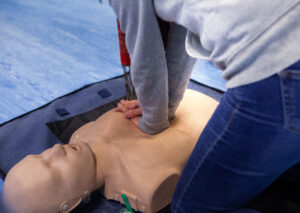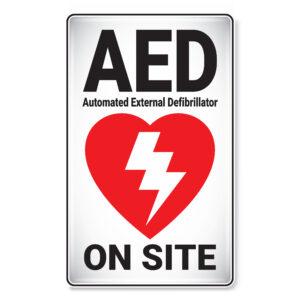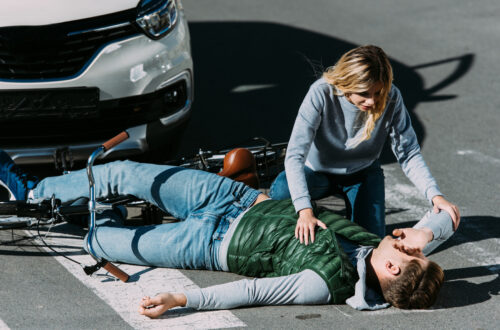
Learn How to Save a Life with CPR and AEDs!
You’re out shopping and you hear a cry for help. Someone has collapsed. It looks like a cardiac arrest. Does anyone know CPR (cardiopulmonary resuscitation)? Is there an automated external defibrillator (AED) nearby? CPR and AED are two essential tools in the race against time during cardiac emergencies. Although CPR-AED Week has passed, it’s still crucial to spread awareness about the importance of these life-saving techniques all year round and equip individuals with the knowledge to act confidently in emergency situations. Decipher Your Health will delve into why this is such a critical issue, provide step-by-step guidance on performing CPR and offer insights on operating an AED.

Cardiac disease is the leading cause of death
Cardiac disease remains the leading cause of death worldwide, affecting both men and women. According to the American Heart Association (AHA), approximately one in three men has some form of cardiovascular disease. The Centers for Disease Control and Prevention (CDC) reports that someone dies every 33 seconds from heart disease. Men are more likely to experience heart attacks at a younger age compared to women. Men typically present with the symptoms of heart pressure, while women may not.
And, contrary to popular belief, heart disease is not just a man’s problem. In fact, cardiovascular disease is the leading cause of death in women too! It claims more lives than all forms of cancer combined. Nearly one in three women dies from heart disease. The symptoms may be more subtle with women though. For example, shortness of breath is a more common symptom than chest pain.
CPR saves lives
 Given how common heart disease is, it’s very helpful to learn CPR. If people receive CPR immediately at the time of cardiac arrest, the chance of survival increases from 10% to almost 40% according to the AHA. CPR is a crucial technique that maintains blood circulation and sends oxygen to vital organs until professional medical help arrives. Here’s a step-by-step guide on performing CPR:
Given how common heart disease is, it’s very helpful to learn CPR. If people receive CPR immediately at the time of cardiac arrest, the chance of survival increases from 10% to almost 40% according to the AHA. CPR is a crucial technique that maintains blood circulation and sends oxygen to vital organs until professional medical help arrives. Here’s a step-by-step guide on performing CPR:
- Assess the scene: Ensure the safety of yourself and others before approaching the person in need. For example, if you are on a busy street, traffic has to be stopped before you can help.
- Check responsiveness: Tap the person and ask if they are okay. If there is no response, shout for help.
- Call Emergency Services: Tell someone to dial the emergency services number (e.g., 911 in the United States) and provide clear and concise information about the situation. Tell someone else to look for an AED.
- Start chest compressions: Place the heel of one hand on the center of the person’s chest, between the nipples. Place the other hand on top, interlacing your fingers. Push down hard and fast, aiming for a rate of 100-120 compressions per minute and a depth of 2 inches. Allow the chest to fully recoil between compressions. The AHA now promotes compression only resuscitation.
- Continue compressions at a rate of 100-120 beats per minute. Sometimes it’s helpful to think of a fast beat song such as “Staying Alive” by the Bee Gees. There are other songs that follow the same fast beat. If you want to learn which ones, Spotify has a CPR certified playlist of 100-120 bpm songs.
 While you are doing compressions have another bystander prepare the AED. If an AED is used within 5 minutes of a cardiac arrest, the chances of the person surviving rises strikingly. A study of sports centers showed that those with an AED had a survival rate of 93% in people with sudden cardiac arrest compared to 9% in those facilities without an AED on site.
While you are doing compressions have another bystander prepare the AED. If an AED is used within 5 minutes of a cardiac arrest, the chances of the person surviving rises strikingly. A study of sports centers showed that those with an AED had a survival rate of 93% in people with sudden cardiac arrest compared to 9% in those facilities without an AED on site.
CPR plus an AED
AEDs are portable devices that deliver an electric shock to the heart during cardiac arrest. They guide you step-by-step so you don’t have to be worried that you may make a mistake.

Here are the steps to operating an AED:
- Power on: Turn on the AED by pressing the power button. The device will provide clear voice prompts and visual instructions.
- Expose the chest: Remove the person’s clothing from the chest to ensure you can place the electrodes properly.
- Attach the electrode pads: Place the electrode pads correctly on the person’s bare chest according to the diagram on the AED pads. Make sure the wires are attached to the AED.
- Analyze heart rhythm: Turn on the AED and allow the device to analyze the heart rhythm. Make sure that no one is touching the person while the AED analyzes their heart rhythm.
- Deliver the shock: If the AED determines that a shock is needed, it will prompt you to press the shock button. Again, be sure that no one is touching the person. Administer the shock as instructed.
- Continue CPR: After delivering the shock, immediately resume chest compressions.
You can save a life
Affecting one out of 3 adults in the United States, cardiac disease is extremely common. Your training could make the difference between life and death.
Look for classes in your community. The American Red Cross offers classes, as do many sports facilities. You can also arrange private or small group classes with certified trainers. By learning these simple techniques, you can save a life!
Here at Decipher Your Heath we hope to continue keeping you healthy and teaching you ways to maximize your health and the health of your loved ones.
Disclaimer
The information in this blog is provided as an information and educational resource only. It is not to be used or relied upon for diagnostic or treatment purposes.
The blog does not represent or guarantee that its information is applicable to a specific patient’s care or treatment. The educational content in this blog is not to be interpreted as medical advice from any of the authors or contributors. It is not to be used as a substitute for treatment or advice from a practicing physician or other healthcare professional.



